| Article ID | Journal | Published Year | Pages | File Type |
|---|---|---|---|---|
| 96647 | Forensic Science International | 2011 | 8 Pages |
Vitreous humor (VH) is used for postmortem diagnosis of metabolic diseases and to clarify the postmortem interval. Because of its viscous nature, this fluid has to be liquefied prior to analysis; however variations in measured concentrations of the analytes are ascribed to different pre-analytical treatment methods with regard to. The aim of this study was to compare different pre-analytical methods. Centrifugation, heat treatment, enzymatic digestion and liquefying by ultrasound were compared using a collection of 120 samples obtained from 2003 to 2007. The determined parameters were: sodium, potassium, chloride, calcium, glucose, creatinine, urea and lactate. Analyses were performed either photometrically or by using ion-selective electrodes.Heat and hyaluronidase treatment generate slightly higher and lower values in the measurement of electrolytes and glucose. However, in the determination of calcium concentration, both methods (heat especially) are associated with extreme low or high values. Only differences between ultrasound and centrifugation treatment show comparatively small variations and are close to instrument accuracy. Therefore, we recommend centrifugation, combined with mixing, as the best and easiest method in which to prepare frozen samples for analysis. Additionally, the measurement of lactate shows that analytical methods, calibrated for serum and urine, cannot be easily applied for VH.
